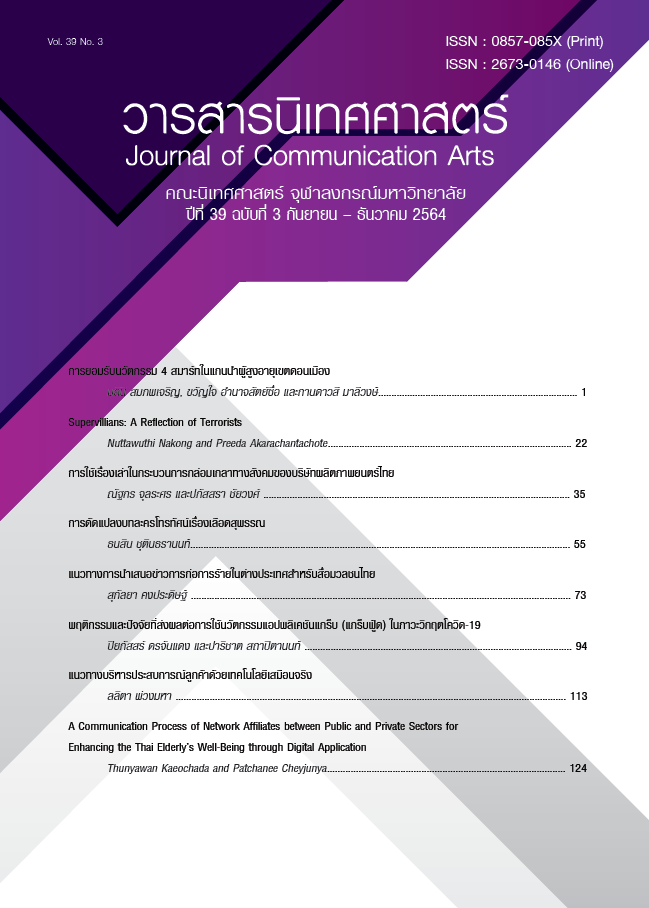Behaviors and Factors Affecting the Innovative Grab Application Usage (Grab Food) During the Covid-19 Crisis
Main Article Content
Abstract
he objectives of this research are 1) to observe the perception, attitudes, and behaviors that affect the application Grab Food usage during the crisis of COVID-19 2) to demonstrate the demographic and behavioral differences affecting the use of application Grab Food 3) to study the relationship between perception, attitudes, and behaviors affecting the use of application Grab Food and 4) to study the factors that affect the use of application Grab Food. The questionnaire was used with the samples of 400 sets. The findings from this research are: 1) the perception towards the benefits of application Grab Food is at a high level, the attitudes towards application Grab Food is at a high level and the application Grab Food usage behavior is more than the normal level 2) the demographic characteristics such as gender, education level and income influence the usage behavior of application Grab Food 3) perception and attitudes towards the application Grab Food show the negative relationship and the usage behavior is in a very low level. While attitudes towards application Grab Food is in a positive relationship and the perception towards the benefits of the application is in the middle level and 4) the factors that explain the behavior that affects the application Grab Food usage is the decision-making attitude during the use of the application.
Article Details
References
กนกวรรณ ครินชัย. (2554). ปัจจัยที่มีผลต่อการดาวน์โหลดแอพพลิเคชัน (application) ของผู้ใช้โทรศัพท์มือถือไอโฟน. วิทยานิพนธ์ปริญญามหาบัณฑิต .มหาวิทยาลัยธรรมศาสตร์, กรุงเทพมหานคร.
กระทรวงมหาดไทย. (2563). คลังข่าวมหาดไทย. วันที่เข้าถึงข้อมูล 10 มีนาคม 2564, แหล่งที่มา www.newskm.moi.go.th
กัญญารัตน์ สมศักดิ์. (2014). ทัศนคติต่อส่วนประสมทางการตลาดบริการและแรงจูงใจมีความสัมพันธ์กับแนวโน้มพฤติกรรมการซื้อคูปองส่วนลดสินค้าและบริการบนเว็บไซต์ Groupon ของผู้บริโภคในประเทศไทย (Doctoral dissertation).
กัลยา วานิชย์บัญชา. (2550). การวิเคราะห์สถิติ: สถิติสำหรับบริหารและวิจัย. กรุงเทพฯ: โรงพิมพ์จุฬาลงกรณ์มหาวิทยาลัย.
กาญจนา แก้วเทพ. (2542). การวิเคราะห์สื่อ : แนวคิดและเทคนิค. กรุงเทพฯ: เอดิสัน เพรส โพรดักส์.
กิตติยา วงศ์นรเศรษฐ์. (2556). แอปพลิเคชั่นบนมือถือ. วันที่เข้าถึงข้อมูล 10 มีนาคม 2565, แหล่งที่มา https://sites.google.com/a/bumail.net/mobileapplication/home.
ดนุรัตน์ ใจดี. (2553). ปัจจัยที่มีผลต่อการตัดสินใจของประชาชนในการเลือกใช้บริการร้านอาหารในจังหวัดสุราษฎร์ธานี. วิทยานิพนธ์ปริญญามหาบัณฑิต ,มหาวิทยาลัยราชภัฏสุราษฎร์ธานี.
ธนาคารแห่งประเทศไทย. (2563). ธุรกิจส่งอาหารแบบดิลิเวอรี่ในปี 2563. วันที่เข้าถึงข้อมูล 10 มีนาคม 2565, แหล่งที่มา http://www.bot.or.th
นันทพร เขียนดวงจันทร์ และขวัญกมล ดอนขวา (2019). ทัศนคติ และความตั้งใจที่มีอิทธิพลต่อพฤติกรรมผู้บริโภคในการซื้อสินค้าผ่านไลน์. Suranaree Journal of Social Science, 13(2), 58-78.
ปริญลัก ษิตานนท์. (2533). กลยุทธ์การตลาด การบริหารการตลาดและกรณีตัวอย่าง. กรุงเทพฯ: สำนักพิมพ์พัฒนาศึกษา.
พรประภา จิตต์วารี. (2018). การแบ่งกลุ่มผู้ใช้บริการสั่งอาหารส่งถึงบ้านโดยใช้รูปแบบการดำเนินชีวิตและพฤติกรรมการใช้บริการสั่งอาหารส่งถึงบ้านในพื้นที่จังหวัดสมุทรสาคร กรณีศึกษา พอร์โต้ชิโน่. Rangsit Graduate Research Conference: RGRC 13, 1113-1122.
ยุบล เบ็ญจรงค์กิจ. (2534). การวิเคราะห์ผู้รับสาร. กรุงเทพฯ: จุฬาลงกรณ์มหาวิทยาลัย.ล้วน สายยศ และอังคณา สายยศ. (2543). เทคนิคการวัดผลกํารเรียนรู้. พิมพ์ครั้งที่ 2. กรุงเทพฯ : สุวีริยาสาส์น.
วสุดา รังสิเสนา ณ อยุธยา และอาษา ตั้งจิตสมคิด. (2560). ปัจจัยที่ส่งผลต่อพฤติกรรมของผู้บริโภคในการใช้บริการสั่งอาหารผ่านสื่อออนไลน์ในเขตกรุงเทพมหานครและปริมณฑล. การประชุมหาดใหญ่วิชาการระดับชาติและนานาชาติ ครั้งที่ 10, 1464-1478
วันเฉลิม และดวง กันยา. ปัจจัยที่ส่งผลต่อการใช้บริการสั่งอาหารออนไลน์แบบจัดส่งถึงที่ในเขตอำเภอเมืองนครราชสีมา. (Doctoral dissertation, สาขาวิชาวิศวกรรมขนส่ง สำนักวิชาวิศวกรรมศาสตร์ มหาวิทยาลัยเทคโนโลยีสุรนารี).
วิเชียร เกตุสิงห์. (2543). ค่าเฉลี่ยกับการแปลความหมาย: เรื่องง่ายๆ ที่บางครั้งก็พลาดได้. กรุงเทพฯ: พิมพ์ดี.
สุนิฏฐา ภู่พงศ์พันธ์. (2555). ทัศนคติและความตั้งใจซื้อคูปองส่วนลดค่าสินค้าและบริการผ่านเว็บไซต์พาณิชยกรรมทางสังคมออนไลน์ของผู้บริโภคในเขตกรุงเทพมหานคร. (การศึกษาค้นคว้าอิสระปริญญาบริหารธุรกิจมหาบัณฑิต สาขาวิชาการตลาด). มหาวิทยาลัยศรีนครินทรวิโรฒ.
สุภาวรรณ ชัยทวีวุฒิกุล. (2555). พฤติกรรมการซื้อสินค้าและบริการออนไลน์แบบร่วมกลุ่มกันซื้อบนเว็บไซต์ ENSOGO ของลูกค้าในเขตกรุงเทพมหานคร. สารนิพนธ์บธ.ม. (การตลาด). กรุงเทพฯ: บัณฑิตวิทยาลัย มหาวิทยาลัยศรีนครินทรวิโรฒ.
อัครเดช ปิ่นสุข. (2558). การยอมรับเทคโนโลยีสารสนเทศ คุณภาพการบริการอิเล็กทรอนิกส์และส่วนประสมการตลาดในมุมมองของลูกค้าที่ส่งผลต่อความพึงพอใจ (E-satisfaction) ในการจองตั๋วภาพยนตร์ออนไลน์ผ่านระบบแอพพลิเคชั่นของผู้ใช้บริการในจังหวัดกรุงเทพมหานคร. (การค้นคว้าอิสระปริญญามหาบัณฑิต). มหาวิทยาลัยกรุงเทพ, กรุงเทพมหานคร.
Statista. (2563) .มูลค่าตลาดฟู้ดเดลิเวอรีในไทยระหว่างปี 2014-2019. วันที่เข้าถึงข้อมูล 10 มีนาคม 2565, แหล่งที่มา https://www.statista.com/statistics/1133528/thailand-food-delivery-market-value/
Ajzen, I. (1985). From intentions to actions: A theory of planned behavior. In Action control: Springer.
Bandura, A. (1986). Social foundations of thought and action. Englewood Cliffs, NJ.
Cox, W., & Klinger, E. (1990). Incentive motivation, affective change, and alcohol use: A model. Why people drink: Parameters of alcohol as a reinforcer, 291-314.
Chisnall, P. (1995), Strategic Business Marketing, 3rd ed., Prentice‐Hall, Englewood Cliffs, NJ.
Davis, F. D. (1989). Perceived usefulness, perceived ease of use, and user acceptance of information technology. MIS quarterly, 319-340.
Kimes, S. E. (2011). Customer perceptions of electronic food ordering.
Rogers, R. D., & Seddon, K. R. (2003). Ionic liquids--solvents of the future? Science, 302(5646), 792-793.
SCHIFFMAN, LG & KANUK, LL. 2000. Consumer behavior.7th ed. London. Prentice Hall.
Solomon. (1966). The orders of the finite Chevalley groups. Journal of Algebra, 3(3), 376-393.Venkatesh, V., Morris, M. G., Davis, G. B., & Davis, F. D. (2003). User acceptance of information technology: Toward a unified view. MIS quarterly, 425-478.
Wiio, O. A., Goldhaber, G. M., & Yates, M. P. (1980). Organizational communication research: Time for reflection? some conclusions from audit and network studies in different countries. Annals of the International Communication Association, 4(1), 83-97.
Yamane, T. (1967). Elementary Sampling theory, Prentice - Hall, INC.Englewood cliffs, N.J.


